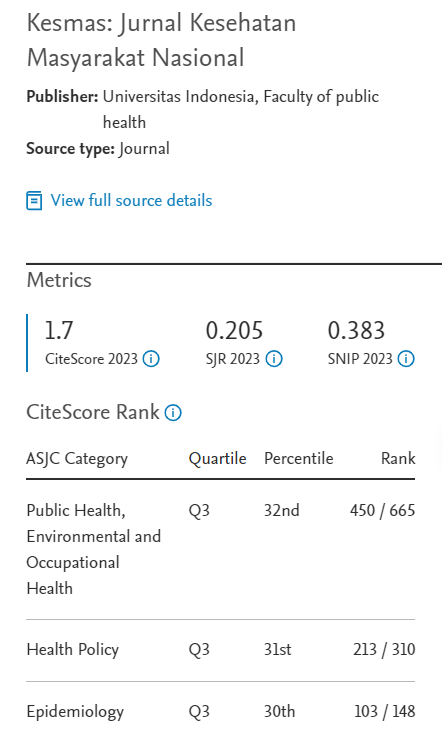Abstract
Kematian dan cedera akibat kecelakaan lalu lintas telah menjadi masalah kesehatan masyarakat di seluruh dunia termasuk Indonesia. Di lingkungan Universitas Indonesia, setiap tahun terjadi peningkatan kejadian kecelakaan. Penelitian ini bertujuan melihat hubungan antara persepsi risiko keselamatan berkendara dengan perilaku penggunaan sabuk keselamatan pada mahasiswa Universitas Indonesia. Penelitian ini menggunakan pendekatan semi kuantitatif dan desain penelitian potong lintang. Partisipan adalah 98 mahasiswa Universitas Indonesia di Kampus Depok, berusia 18-25 tahun yang mengendarai kendaraan sendiri. Faktor internal yang membentuk persepsi risiko keselamatan berkendara secara bermakna adalah pengalaman (nilai p = 0,000) dan kepercayaan (nilai p = 0,008), sedangkan faktor eksternal yang signifikan adalah pengaruh teman (nilai p =0,000). Responden yang mempunyai persepsi risiko keselamatan berkendara yang buruk berisiko tidak menggunakan sabuk keselamatan 72 kali lebih besar [OR 72,46 (15,26; 344,02)] daripada responden yang mempunyai persepsi risiko terhadap keselamatan berkendara yang baik. Perlu dilakukan upaya meningkatkan persepsi risiko antara lain melakukan hazard communication dengan menggunakan pengalaman teman sebagai salah satu sumber informasi bagi individu, disebarluaskan melalui website, pemutaran film kejadian kecelakaan, dan membuat papan informasi yang diletakkan pada gerbang utama, meliputi informasi secara berkala dan berkelanjutan tentang kejadian kematian, cedera, dan luka-luka akibat kecelakaan lalu lintas.
Deaths and injuries caused by traffic accidents has become a public health problem not only in Indonesia but throughout the world. Based on the data of UPTK3LH University of Indonesia, there is increasing incident and accident in campus within the university each year. The aim of this study is to see the relationship between perception of risk driving safety with safety belts usage behavior among the University of Indonesia students, using semi-quantitative approach and cross-sectional research design. Participants were 98 students of University of Indonesia Depok aged 18 to 25 years who drive their own vehicles. With 5% a, 80% power of the test and SPSS 10:00 software, obtained significant internal factors shape the perception of safety risks are the driving experience (p value = 0.000) and confidence (p value = 0.008), whereas a significant external factor is the influence of friends (p value =0.000). Respondents who have bad perceptions of the driving safety risk have a chance of 72 times [OR 72.46 (15.26; 344.02)] for not using safety belts compared to respondents who have a good perception of driving safety risk. Efforts are required to increase the risk perception include hazard communication by using the experience of a friend as one source of information for individuals, spread through websites, film screenings of an accident scene, and create information boards placed at the main gate, from the death scene information, injury, and injuries due to traffic accidents. The most important things is regular socialization
References
- Garcia-Ferrer, Aranzazu De Juan A, Poncela P. The relationship between road traffic accidents and real ecomonic activity in Spain: Common cycles and health issues. Health Economic. 2007;16: 602-26.
- Departeman Perhubungan Direktorat Jenderal Perhubungan Darat Direktorat Keselamatan Transportasi Darat Satuan Kerja Peningkatan Keselamatan Transportasi Darat. Penyusunan rencana umum keselamatan transportasi darat. Jakarta: Departemen Perhubungan Darat; 2006.
- Botterill L, Mazur N. Risk and risk perception: a literature review. RIRDC Publication; 2004.
- Pender NJ. Health promotion in nursing practice. 4th ed. New Jersey, USA: Prentice Hall; 2002.
- Ariawan I. Besar dan metode sampel pada penelitian kesehatan. Depok: Jurusan Biostat dan Kependudukan FKM UI;1998.
- Jaccard J, Dodge T, Blanton H. Peer influences on risk behavior: an analysis of the effects of a close friend. Developmental Psychology American Psychological Association. 2005; 1 (41): 135–14.
- Geller ES. The psycology of safety handbook. USA: Lewis Publishers; 2001.
- Ropek D, Slovic P. Risk in perspective. Harvard Certer for Risk Analysis. 2003:11(2).
- Glendon AI, Dorn L, Davies R, Matthews G, Taylor RG. Age and gender differences in perceived accident likelihood and driver competences. Journal of Risk Analvsis. 1996: 16 (6).
- Williamson J, Weyman A. Review of the perception of risk, and stakeholder engagement. USA: Health & Safety Laboratory; 2005.
- Cohen A, Einav L. The effect of mandatory seat belt law on driving behavior and traffic fatalities. The MIT Press; 2003.
- Cohen A, Liran E. The effect of mandatory seat belt law on driving behavior and traffic fatalities. USA: The MIT Press; 2003.
- Afdjani H. Efek psikologi pemberitaan media massa terhadap khalayak ditinjau dari teori peluru, agenda setting dan uses gratification [tesis]. Jakarta: Universitas Budi Luhur; 2007.
Recommended Citation
Salihat IK , Kurniawidjaja L .
Persepsi Risiko Berkendara dan Perilaku Penggunaan Sabuk Keselamatan di Kampus Universitas Indonesia, Depok.
Kesmas.
2010;
4(6):
275-280
DOI: 10.21109/kesmas.v4i6.167
Available at:
https://scholarhub.ui.ac.id/kesmas/vol4/iss6/6







